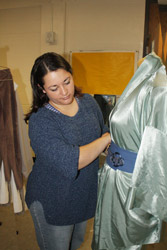Color, simplicity make costumes
The Advocate
When it comes to costumes, it’s all about color for DeMara Cabrera.
“Color is the first thing we react to as human beings, as audience members,” Cabrera said.
And in designing for this year’s Children’s Theater production, “The Emperor’s Dragon” color was integral.
“The show is set in ancient Japan during the samurai era but it’s a children’s show,” Cabrera said. “We picked the colors very consciously.”
|
|||
Inspiration for Cabrera came in various forms, including a Disney film.
“We were looking for ideas similar to ‘Mulan,’ ” Cabrera said. “You simplify (and) create costumes that are easily identifiable.”
For instance, Cabrera said the main character Tarao would be in primary colors to stand out while the two armies would be distinguishable since one would be in warm colors, the other in cool.
Aside from “Mulan,” Cabrera said, “We had one art image that was the inspiration for the colors.” The image depicted a dragon and Japanese warriors. When it came to creating the Japanese warriors for the stage, Cabrera said the armor was a “big project.”
“It’s brought from the Japanese tradition where they would make very thick fabric in an attempt to protect the body,” she said.
Director Paul Navarro said, “DeMara has come up with some very creative solutions to a very tight budget.
This is Cabrera’s second time at MHCC, having done costumes for “The Mystery of Edwin Drood.” She came on after Technical Director Daryl Harrison-Carson recommended her to Navarro.
“She came on last minute when our usual costumer could not do the show, but she’s proven to be very good to work with and very talented,” Navarro said.
Cabrera said she was drawn to the show because “it sounded like a really fun show. The idea of doing a children’s show really appeals to me and I love working here.”
Cabrera learned to sew when she was 4 years old and started designing costumes in high school. Cabrera went on to earn a degree in theatrical design and now does costumes for various shows.
“I think good costume design helps tell the story, supports it,” Cabrera said. “I don’t necessarily think they should be the most outstanding aspect of the show, they shouldn’t detract. They should work cohesively with the lights, the set, with the telling of the story.”
It is this cohesion between elements that Cabrera is anticipating the most.
“That’s the most exciting part, to see it all come together,” she said. “I have this idea in my head about how it will look but you never know until you see it onstage with the actors, with the lights (and) with the set.”
![]()
The Advocate reserves the right to not publish comments based on their appropriateness.
![]()
Notice: Undefined variable: c5t_output in /hermes/walnacweb06/walnacweb06ac/b2874/moo.advocateonlinenet1/mhccadvocate/103009/AE_Costumes.php on line 217
![]()

